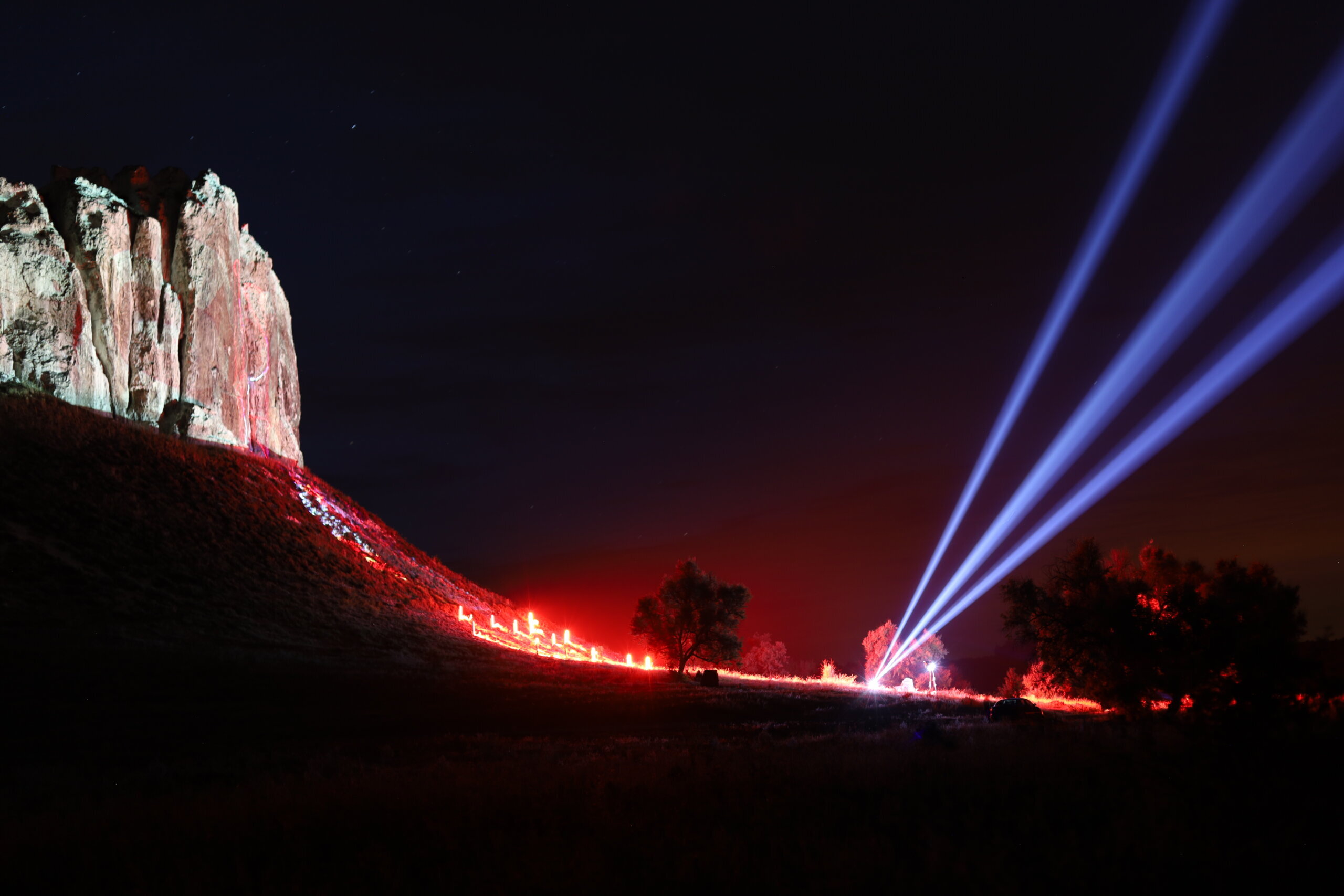BELOKUZMINOVKA MOUNTAINS, Donetsk Oblast, Ukraine — The cretaceous rock formation towers at 25 meters high, surrounded by calm swamplands and sleepy villages. But on the night of the summer solstice, it was anything but.
The moment the sun set over the horizon, the croaking of the frogs was slowly drowned out by music. A deep low sound started to pump through the air, the vibrations felt in the ground itself. Techno beats took the pace of bright lights and lasers dancing along the vertical chalk wall. The tempo grew quicker and quicker until the lasers came together to form a word, Shum — “noise” in Ukrainian. It shone brightly on the mountain for all in the surrounding swamplands to see.
The light show marked the beginning of Shum, an underground rave taking place just 60 kilometers from the front line in Russia’s war against Ukraine.
The start of Shum
The first thing many people think of when they think about Slovyansk — a city of nearly 110,000 people 625 kilometers southeast of Kyiv — is that it was the first city to be fully seized by Russia-backed militants in 2014, marking the start of the brutal war in the Donbas.
The town lived under Russian occupation for about three months, until its liberation by Ukrainian forces in July 2014.
The war fundamentally changed the city. Recreation centers and cafes shelled six years ago still stand — broken and unused.
A noise curfew starting at 11 p.m. leaves the younger residents of Slovyansk unoccupied, the time filled with uncomfortable silence.
“I just wanted a place for us young people to get together and have a fun time. After 11 p.m., it is impossible to make noise in the city. And I can’t feel comfortable in this silence.”
That’s what Eugene Skrypnyk, the founder of Shum, wrote on Instagram.
Standing under a tree at the base of Belokuzminovka Mountain, a cigarette in hand, Skrypnyk described the start of this underground rave movement.
“We decided, let’s make an alternative place, something of our own, and free. Where you come, and do not care how you are dressed, or what you love. The most important thing is that you feel relaxed and you enjoy that you are there at that party,” Skrypnyk said.
Shum was also created out of love. Ira Litvinova, who Skrypnyk calls his “muse,” wanted a place to dance and enjoy herself in their city.
“When you love someone, you will do anything for them,” Skrypnyk said.

Founder of Shum Eugene Skrypnyk and his partner Ira Litvinova at the first Shum rave in September 2019 in Slovyansk, Donetsk Oblast. (Dima Kosh )
Litvinova, in turn, encouraged Skrypnyk’s idea and told him that he could do anything — if he wanted to create a rave event for the youth of their town, he could make it happen.
And he did. The first Shum rave was held in an abandoned building in the center of Slovyansk in September 2019. While Skrypnyk handled most of the organizing, Litvinova had the connections to DJs from her experience of working at Kultura Zvuka, a prominent music establishment in Kharkiv.
A hundred people came and danced on the unfinished concrete floors, kicking up years-old dust into the air.
Although it made breathing difficult, the young residents of the city stayed and lost themselves in the hard techno, dancing in the cloud of dust, which created a colorful haze reacting to the lights. By the time the rave ended at 7 a.m., people were completely covered in a layer of the white powder.

People dance at Shum’s first rave held in an abandoned building in September 2019 in Slovyansk, Donetsk Oblast, Ukraine (Dima Kosh)
By Shum’s third rave in February, almost 200 people came to dance — and not only from Slovyansk. People came all the way from towns like Kramatorsk, Druzhkovka and the smaller surrounding villages in Donetsk Oblast.
Katya Dubovik, participant in Shum and student in Kharkiv, already feels how Shum has changed the culture of eastern Ukraine.
“It’s crazy. When I told people in Kharkiv that I was from Slovyansk, the response was always ‘Slovyansk — where the war is.’ Now the response is ‘Slovyansk — where Shum is!”
Bringing beauty to Donbas
The coronavirus pandemic canceled Shum’s rave in April. But it didn’t stop the group’s efforts to change the narrative and culture around eastern Ukraine.
In June, Shum received support from the UN Recovery and Peacebuilding Program to film videos showcasing beautiful parts of eastern Ukraine through their rising techno culture and improve tourism within the regions.
The first was at the Belokuzminovka Mountains in Donetsk Oblast.

The Belokuzminovka Mountains in Donetsk Oblast, Ukraine (Elina Kent)
Skrypnyk, Litvinova and their close friends drove to the mountains at 5 p.m., blasting the techno music that was about to be performed. Standing up through the sunroof, wind in their hair, they approached the soon-to-be site of techno and lights.

Eugene Skrypnyk on the way to the Belokuzminovka Mountains (Elina Kent)
Once the show began, the lasers danced brightly along the 25-meter high wall. Due to quarantine measures, it was not an open rave, but a moment to showcase this location and DJ Podryzhanya, a local from Kharkiv, in a video to be seen online.

DJ Podryzhanya performs under the Belokuzminovka Mountains on June 20, 2020 for Shum’s first promo video. (Elina Kent )
The lights and animated lasers were visible for miles and for all residents of the nearby Belokuzminovka village to see. Families gathered at the beginning of the night, dancing along to the rhythm. By midnight, it was time for the children to go to bed, but they were soon replaced with dark figures, beers in hand, wading out from the swamp grass. Villagers who had been drinking across the swamp saw the opportunity of a free show and made the trip through the chest-high grass.
Skrypnyk spent most of the night directing the show and answering the locals’ questions. Many asked when he was going to create a festival in this location for Ukrainians to visit.
“If you can find me an open and willing wallet, then I’ll make it happen,” he responded.
By the time the show ended, it was 4 a.m., the sun already up and shining. Tired but excited, the group drove back home to prepare for their next show in Luhansk Oblast.

A DJ performs at Shum’s rave under the Belokuzminovka Mountains in Donetsk Oblast on June 20, 2020. (Dima Kosh )
Cradle of Donbass
Lysychansk in Luhansk Oblast, located 50 kilometers from the front line, is known as the “cradle of the Donbas.” Before the war, it had around 100,000 residents. But as the conflict raged on, more than 30,000 people fled, leaving Lysychansk with a feeling of emptiness.
Natalia Bogatyreva is a local resident who is involved with the UN as part of the Geoinformation Monitoring and Analysis System, a group of activists working to resolve conflicts in eastern Ukraine on a local level. They spent several weekends cleaning an abandoned Belgian hospital in their city and bringing positive change to the region.
“I would describe Lysychansk as a place with a rich history,” Bogatyreva told the Kyiv Post. “The year 2014 brought wounds to the population. We are traumatized people, but in terms of hope, we wonder what the future of industrial development will be like.”
The hospital Bogatyreva helped clean would become the next site for Shum.
Bringing attention to this region is what Shum would like to do through its second filmed rave set by using its audience’s interest in techno to put Lysychansk on the map and showcase the town’s history.
With the rave, they wanted to take what was once broken and transform it into a beautiful light show. Another DJ from eastern Ukraine, DJ Vlad Fisun, was the one to perform.

DJ Vlad Fisun performs on July 18, 2020 in Lysychansk, Luhansk Oblast for Shum’s second promo video. (Elina Kent )
Techno, funk and American hip-hop filled the air. Lights shone against the building. And, that night, the Neowise comet coincidentally flew through heavens above, leaving a white streak against the night sky over this eastern town. The experience of the night definitely felt cosmic.
Psychedelic colors played across the building and a projection of an old man with a luxurious mustache shone in the center. It was an homage to the founder of the hospital, Belgian chemist Ernest Solve.

A projection of Belgian chemist Ernest Solve lit against the abandoned children’s hospital in Lysychansk, Luhansk Oblast, on July 18, 2020. (Elina Kent )
Belgium used to be one of the biggest investors in the industry of eastern Ukraine during the late 19th century. Solve himself started to invest in Lysychansk back in 1892, starting with a soda bicarbonate factory, then a children’s hospital and several other industrial buildings to support mining in the area.
“The industrialization of the Donbas started from this baking soda factory,” Bogatyreva said. “And it functioned until 2014, and then it was simply cut to pieces. It was one of the largest factories in Ukraine.”
The overarching theme in Lysychansk was its previous industrial strength — now broken down and abandoned.
Chalk, sand, coal — all these resources remain, but the people have not.
“I understand that our town will not recover on an industrial level. But we hope to at least revive it culturally,” Bogatyreva said.
The residents of Lysychansk hope that buildings can be renovated and given new functions to help preserve the history of eastern Ukraine.
The future of Shum
Shum wants to bring that kind of attention to eastern Ukraine. Made up of a group of people largely in their twenties, they understand it is their responsibility to revive their region.
“I now understand that my place is in Sloviansk,” Skrypnyk said.
“People like to go to Kyiv or to the west of Ukraine. We want people to understand that it’s cool here, too,” Litvinova added. “We want Ukrainians to feel excited and come to eastern Ukraine as well.”
Shum set up a patreon account in order to continue to host future raves in the east of Ukraine.
Since Sloviansk is currently considered a “green zone” in Ukraine’s adaptive quarantine measures, which allows mass gatherings, Shum announced on Instagram (@shum.rave) that it will hold a rave on Aug. 22. This one will be considered a pre-party to the 4th official Shum rave, which the organizers plan to host on the one-year anniversary of the event in September.
The rave on Aug. 22 will respect COVID-19 restrictions and the participants will be required to wear face masks and undergo body temperature checks.
The lineup of DJs:
Crematorium from Severodonetsk
LIBR:A from Kultura Zvuka
Panghound from Kharkiv
Yooly from Kyiv
JmDasha b2b and Podryzhanya
Tickets: Hr 200 online, Hr 250 at the door.
Location: At the Upravlenie Kerama building (48.8418723, 37.5845940) in Slovyansk, from 10 p.m. to 8 a.m.
The easiest way of getting to Slovyansk from Kyiv is by train, as the station is now open, with a second class ticket at about Hr 500.
